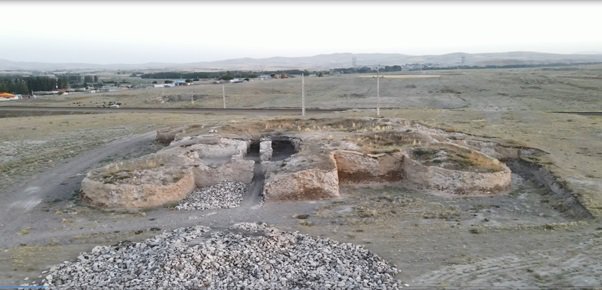Archaeologists excavate castle shedding light on ancient architecture in Ojan

TEHRAN–Archaeologists have uncovered a former governmental castle in ancient Ojan, which was once a thriving town in northwestern Iran during the Seljuk and Ilkhanid eras.
“During this season of excavation, a team of archaeologists carved four trenches into the ruined castle so that experts could enter the interior of the governmental monument,” CHTN quoted archaeologist Mohammadrahim Velayati as saying on Saturday.
“Contrary to our initial expectation, the interior space embraces a large hypostyle hall,” said the archaeologist who led the team.
“We previously assumed, regarding specifications of the roof where those four trenches carved, that the interior has several rooms divided between stone walls coated with plaster mortar.”
However, the new insight came to light when columns were found after debris removal, the archaeologist said.
Late in June, the team commenced work to fill the gaps between the written records and archaeological findings in the ancient city, which is located in the Bostanabad district of East Azarbaijan province.
“According to written sources, during the Seljuk and Ilkhanid periods, the entrance to the castle was on the eastern front, so one of the trenches was dug right there with the help of students from the University of Tehran.”
This trench, at a depth of 30 cm, led to the discovery of a gate column… However, further excavation uncovered evidence that an eastern entrance was constructed in Safavid style after a severe earthquake caused extensive destruction on the opposite side, Velayati explained.
Early buildings in Ojan date back to the 5th-6th centuries AH and coincided with the Seljuks. Later, the city was an administrative center of the Ilkhanids in the 7th-8th AH centuries and experienced its heyday until the late Safavid period.
Surviving architectural structures include square-shaped battlements, a government castle, some surveillance towers, enclosed walls, incised underglaze clays, underglaze paintings, and local clays without glaze from the 6th-8th centuries.
The Ilkhanid dynasty, also called Il-Khanid, was a Mongol dynasty that ruled Iran from 1256 to 1335. Il-Khan is Persian for “subordinate khan.”
Hulegu, a grandson of Genghis Khan, received orders from the supreme Mongol chieftain Mongke to conquer Iran. Hulegu set out around 1253 with a Mongol army of about 130,000 men. He founded the Il-Khanid dynasty in 1256 and conquered Baghdad and all of Iran by 1258, according to Britannica.
The Il-Khanids consolidated their position in Iran and unified the region as a political and territorial entity after several centuries of fragmented rule by small dynasties. During the reign of the Il-Khanid Maumud Ghuzun (r. 1295-1304), the Il-Khanids lost all contact with the remaining Mongol chiefs in China. Mahmud Ghuzun himself embraced Sunni Islam, and his reign was a time of Iranian cultural renaissance in Iran, with scholars such as Rashid al-Din flourishing under his patronage.
Ghazan’s brother Oljeitu (r. 1304-16) converted to Shia Islam in 1310. Oljeitu’s conversion caused great unrest, and when he died in 1316, the civil war was imminent. His son and successor, Abu Sa’id (r. 1317-35), converted to Sunni Islam and was thus able to prevent a war.
During Abu Sa’id’s reign, however, factional disputes and internal unrest continued to spread. Abu Sa’id died without leaving an heir, and with his death, the unity of the dynasty was broken. Thereafter, various Il-Khanid princes ruled parts of the dynasty’s former territory until 1353.
AM
Leave a Comment